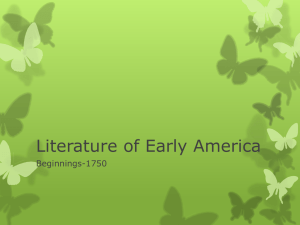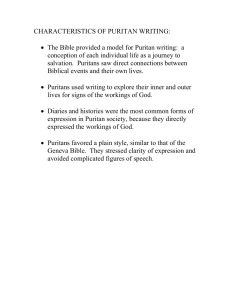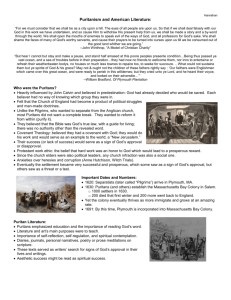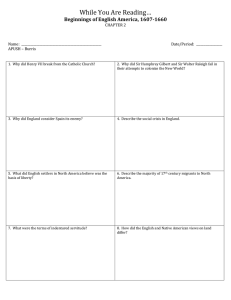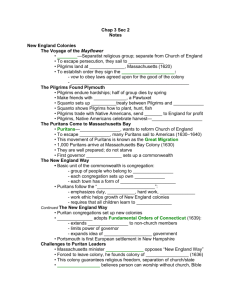Historical/Cultural Context for Puritans and Pilgrims
advertisement
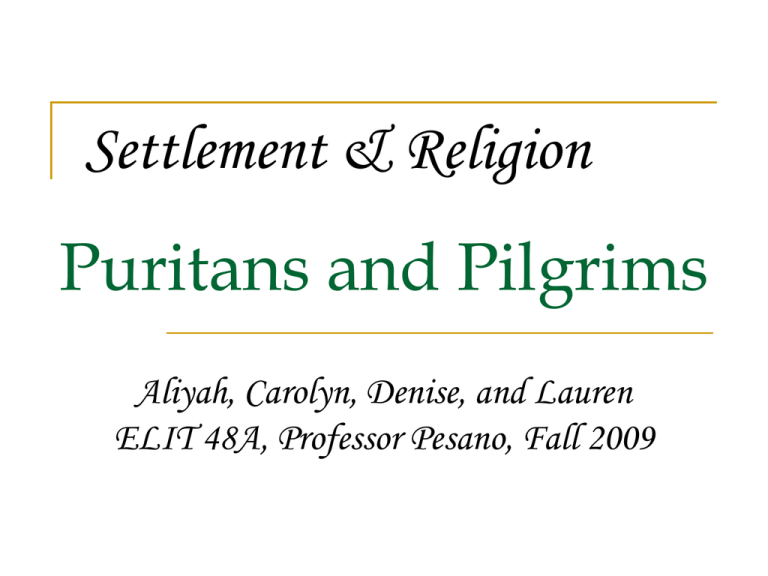
Settlement & Religion Puritans and Pilgrims Aliyah, Carolyn, Denise, and Lauren ELIT 48A, Professor Pesano, Fall 2009 History In 1608 when King James Stuart succeeded Queen Elizabeth, the Puritans fled to the Netherlands and then asked for the right to settle in the vast holdings the British held in America. The Pilgrims (1620) and the Puritans (1630) came and settled in Massachusetts. The Puritans wanted to build the “New Jerusalem” or Boston as it came to be known. The Quakers (bad name for pacifists) came and settled in the Pennsylvania area. The Catholics came and settled in Mary’s Land to escape persecution (later became Maryland) **Map of the first colonies settled during the time of the puritans and pilgrims. History Important Events: Back to the book… The most famous, or infamous, event of this time was the Salem witch hunt and trials. The Salem witch trials were a series of hearings before local magistrates followed by county court trials to prosecute people accused of witchcraft in Essex, Suffolk, and Middlesex counties of colony Massachusetts, between February 1692 and May 1693. As the Norton Anthology mentions, the Pilgrims who came to Plymouth Plantation wished to purify their Christian beliefs and practices. However, the Puritans initially were willing to work within the confines of the established Church of England, the Pilgrims thought it so corrupt that they wished to separate themselves from it completely. Pilgrims vs. Puritans… The "Pilgrim Fathers" who fled to the Netherlands, and then to New England on the Mayflower, were Puritans. "Pilgrims" is the name that has stuck for this particular group of English Separatists. Their beliefs, however, were not materially different from those of the Puritans settlers who followed them to New England in the 1630s. Religious views of the Pilgrims The pilgrims shared the views of the Separatist: they believed that the reforms of the Anglican Church had gone far enough. To establish themselves as rightful interpreters of the Bible, they removed from the Anglican Church in order to re-establish it as they believed it should be. The first of their reasons for sailing to America is fairly passive – they wanted to “draw” others by the example of their prosperity, not necessarily go and conquer and actively convert. Such an idea reflects the one that would be expressed by the Puritan John Winthrop, where the New World would become a beacon of religious light, a model of spiritual promise, and a “citty upon a hill” Religious views of the Puritans The most obvious difference between the Pilgrims and the Puritans is that the Puritans had no intention of breaking with the Anglican Church. The Puritans had suffered repeatedly under a society which had seemed to demonstrate the potentially ominous side of the relation of church and state. The king was the leader of the church, and the state decided how the church was to function In 1629 when Charles I dissolved parliament, the people found that they no longer had any political representation Their secular agency had then become a measure of their religious agency The removal to Massachusetts was a way to gain a political voice, to create a state that would develop according to their own beliefs and fashion itself harmoniously with the church Religious views (continued) Puritans and Pilgrims were nonconformists; both of which refused to accept an authority beyond that of the revealed word (the Bible). The Puritans were ardent reformers, seeking to bring the Church to a state of “purity” (as NAAL states) This reform involved varying degrees of stripping away practices seen as residual “popery” – vestments, ceremony, etc. However, where the Pilgrims had translated this in something of an egalitarian mode, the Puritans considered religion a very complex and highly intellectual affair. Its leaders were highly trained scholars whose education tended to lead to authoritarian positions. While these views fostered such class distinction, it nevertheless encouraged education among the whole of its group, and in fact demanded a level of learning and understanding in terms of salvation. Knowledge of Scripture and divinity, for the Puritans, was essential. Philosophy Religious beliefs were the basis of their outlook on life Legal documents influenced by the Bible and English common law Puritans held education in high esteem Misconceptions Women were treated as property Religious perspectives Social and legal perspectives (“The Prologue”) Roles of women in the home Plymouth Colony advantages Misconceptions (continued) Salem witch trials Public humiliation The First Thanksgiving Authors William Bradford (1590-1657) Was born in Austerfield, Yorkshire, into a family of substantial yeomen, March 19, 1589. Read the bible when he was 12 and joined a separatist group that would later become the Pilgrims in 1606. After the Mayflower anchored, his wife fell/jumped overboard and drowned Was elected Governor of Plymouth in April of 1621 and started to write the history of Plymouth Plantation. Was re-elected 30 times. Died May 9, 1657 William Bradford (continued) Of Plymouth Plantation (1620-1637) Portrays suffering of early settlers and their trip across the sea to the New World. Upon landing, they had neither shelter nor knowledge of how to survive. Settlers set out to look for supplies Found corn buried by Indians Some went off to sail around Cape Cod and were attacked by Native Americans during their exploration. The explorers later found cornfields and fresh water during their searches through the wilderness. Half the people died in the first few months of landing. As life settled down, the Pilgrims began to form relations with the surrounding Native American tribes through men such as Samoset and Squanto who served as intermediaries. Indians helped teach them to grow and hunt for food. Spoke of Morton of Merrymount’s lavish lifestyle and eventual fall. Described his fear of the community’s increasing neglect of the Church. Apprehensive concerning the large amount of people who broke away from the Church community to life on their own. Saw it as the ruin of society Documented the first years of the Pilgrim settlements in Plymouth, Massachusetts. Portrayed the suffering of the Pilgrims as they attempted to survive the new landscape. Described the small details behind the glorious image of the first settlers in the New World. Recordings serve as a historical log of the everyday struggles the men and women faced as they built the foundations of a new society. Anne Bradstreet (1612-1672) Was born in 1612 Received education superior to most women of her time Married Simon Bradstreet when she was 16 Did not have healthy disposition, was frail and weak She had 8 children Both her husband and father became Governors of Massachusetts Died in 1672 Anne Bradstreet (continued) “The Prologue to Her Book” (1650) and “The Author to Her Book” (1678) Spoke humbly in introduction of her poetry Affectionately described her poetry as flawed creation that was not worth much merit besides as a tool to amuse and express herself. “To My Dear and Loving Husband” (1678) Displayed her love and devotion to her husband, Simon Bradstreet Simon is represented as the center of her world A few other works “Before the Birth of one of Her Children” (1678) “To My Dear Children” (1867) “Contemplations” (1678) Depicted the Puritan life in the home Spoke of the simplistic home life of a Puritan wife. Men and women each had duties to perform. Fulfilled herself by being a good wife, mother, and poet. Depicted the small joys in life even as everyone continued to struggle to survive in the colonies. John Edward (1703-1758) Born at East Windsor, Connecticut in 1703 Entered Yale University at the age of 13 Married Sarah Pierrepont of New Haven, in his early 20’s Began preaching at one of the leading American Churches in Northampton, Massachusetts He was dismissed from his Church in 1750 for his insistence that only those who had experienced “Grace” should be allowed to be members of the Church. Became President of Princeton University in 1757 Died in of smallpox inoculation in 1758 John Edward (continued) “Sinners in the Hands of an Angry God” Sinners have a possibility of facing destruction at any moment and are already condemned to hell no matter how much they attempt to avoid it. God can send sinners to hell whenever he desires and does not lack the power to do so. God’s wrath is expressed in the fiery tortures of hell. This is a warning to everyone to avoid sin and others to convert and turn towards God to be saved. The rest shall be damned. God shows no mercy in exacting his justice and should be feared. Reveals unforgiving Puritan views of religion Religion is all encompassing of life and should be used as a set of guidelines. Every word and action is seen in black and white. God is depicted as a harsh and omnipotent ruler who is always present. There is no room for negligence. The strict religious codes are continuously in effect. John Winthrop (1588-1649) Born in Groton, England in 1588 Went to Cambridge University for 2 Years, was exposed to Puritan beliefs here. Was married when he was 17 Was not a Separatist Wanted to reform the National Church from within getting rid of hierarchal clergy and traditional rituals. Became a lawyer Emigrated to America in order to avoid persecution under King Charles I In October 1629 he was chosen as Governor of the colony in Massachusetts, and remained in the position for 20 years Died in 1649 John Winthrop (continued) A Model of Christian Charity (1630) God made men different to provide a variance to life and show his power through his proper maintenance of all the diversity. Men should bond together and support each other. Treat each other with justice and mercy. Take care of the lives and belongings of others as though they were your own. People must help each other even beyond their abilities. Sacrifice one’s needs for the good of others. Love is the perfect bond between people. Reveals another aspect of Puritanism Expresses a gentler and more compassionate view of religion. God is seen as a merciful and kind fatherly figure who desires to see His children unite. Religion is still seen as the center of life, but is less constraining. Everything is done out of personal kindness rather than mere fear of condemnation and punishment. Portrays the softer and more emotional aspect of the Puritan culture. Related Literature Nathaniel Hawthorne (1804-1864) Was born at Salem, Massachusetts, July 4, 1804 Two of his ancestors served as judges during the infamous Salem Witch Trials Hawthorne added the “w” to his last name to distance himself from his ancestors. Is most famous for his novel about the Puritans “The Scarlet A” The Scarlet Letter (1850) Summary: Hester Prynne is a woman who committed adultery while her husband, Roger Chillingworth, was absent from the town. Hester is forced to wear the scarlet “A” on her chest to represent her sin. Throughout the novel, Hester refuses to reveal the father of her child to be the beloved town minister, Arthur Dimmesdale. In the process, Dimmesdale goes through an internal struggle with the truth until the end where he reveals his sin and then dies. Nathaniel Hawthorne (continued) Promotes the image of Puritan societies as being cold and merciless Depicts the rigid and strict culture of the Puritans. The scarlet A shows the Puritan belief of making an example of sinners. Reveals the restraints placed on the Puritan people and the religious expectations of each person. Puritans were seen as callous and judgmental men and women who were always ready to condemn any rebellious members of their society. John Milton (1608-1674) Was an English poet, author, polemicist, and civil servant for the Commonwealth of England. He is best known for his epic poem, Paradise Lost, and for his treatise condemning censorship, Areopagitica. Paradise Lost (1667) In his anger against God for choosing his Son to be his secondin-command, Lucifer raises up a rebellion against the army of heaven. In spite, Lucifer tricks Eve into eating the forbidden fruit. Adam eats the fruit because he does not wish to part from Eve. God condemns mankind to suffer because of Adam and Eve’s disobedience. Lucifer and the other fallen angels see evil as their “good” through a twisted sense of reasoning. Lucifer continues to wreak havoc and destruction in battle against God. John Milton (continued) Relations to Puritan views of life Humans seen as creatures who are weak and easily tempted by evil. Women illustrated as foolish creatures. The love, seen as a weakness, Adam had for Eve led him to rebel against God and fall from grace. Similar image of a harsh God. Sins are black and white without any middle-ground. Promotes obedience and strict adherence to religious traditions. Evil is always around and if people are not cautious, they will stray and be condemned to hell. Other Prominent Writers During This Time: Roger Williams (1603-1649) Mary Rowlandson (1636-1711) A Narrative of the Captivity and Restoration of Mrs. Mary Rowlandson (1682) Was captured by the Wampanoag Indians and taken into captivity for 11 months during the series of attacks on the colonial settlements starting in 1675 called “King Phillip’s War.” Wrote about her life as a captive Details the life of a minister’s wife during the rough times of war chaos in the colonies. Edward Taylor (1642-1729) A Key into the Language of America (1643) Preparatory Meditations (1939) “Upon Wedlock, and Death of Children” (1939) Cotton Mather (1663-1728) The Wonders of the Invisible World (1692-1693)
